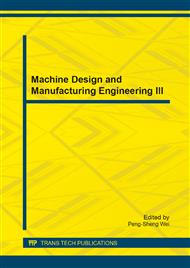p.149
p.153
p.161
p.166
p.171
p.176
p.181
p.185
p.193
Implementation of Magnetic Damping to Reduce Chatter Amplitude and Tool Wear during Turning of Stainless Steel AISI 304
Abstract:
Machine tool chatter is a type of intensive self-excited vibration of the individual components in a machine-tool-fixture-work system. Chatter affects the cutting process and may lead to negative effects concerning surface quality, cutting tool life, and machining precision. However, modern manufacturing industries and their end users demand fine surface finish, high dimensional accuracy as well as low operation costs which include the cost of tooling. Therefore, any effective damping technique, which reduces or eliminates chatter, will significantly improve tool life and will be a profitable technique to implement in the industry. This paper presents a novel chatter control method in turning of (AISI 304) stainless steel by using permanent magnets. The study compared tool wear under two different cutting conditions: normal turning and turning with magnetic damping. A specail fixture made of mild steel was designed and fabricated in order to attach a powerful neodymium permanent magnet (4500 Gauss) to the carraige of a Harrison M390 engine lathe. The arrangement ensured that the magnet was placed exactly below the tool shank. The main idea was that the magnet will provide effective damping by attracting the steel tool shank and restricting its vertical vibratory motion during cutting operations. A Kistler 50g accelerometer, placed at the bottom front end of the tool shank was used to sense vibration. The data was then collected using a Dewetron DAQ module and analyzed using Dewesoft (version 7) software in a powerful Dell workstation. Response surface methodology (RSM) in Design Expert software (version 6) was used to design the sequence of experiments needed based on three primary cutting parameters: cutting speed, feed, and depth of cut. The tool overhang was kept constant at 120 mm in order to facilitate the attachment of the magnet fixture. Analysis of the recorded vibration signals in the frequency domain indicated that significant reduction in the vibration amplitude, as much as 86%, was obtained with magnetic damping. Next tool wear was analysed and measured using a scanning electron microscope (SEM). It is found that tool wear is reduced considerably by a maximum of 87.8% with the magnetic damping method. Therefore, this new magnetic damping method can be very cost effective, in terms of vibration reduction and tool life extension, if applied to industrial turning operations of metals.
Info:
Periodical:
Pages:
171-175
Citation:
Online since:
July 2014
Keywords:
Price:
Сopyright:
© 2014 Trans Tech Publications Ltd. All Rights Reserved
Share:
Citation:


